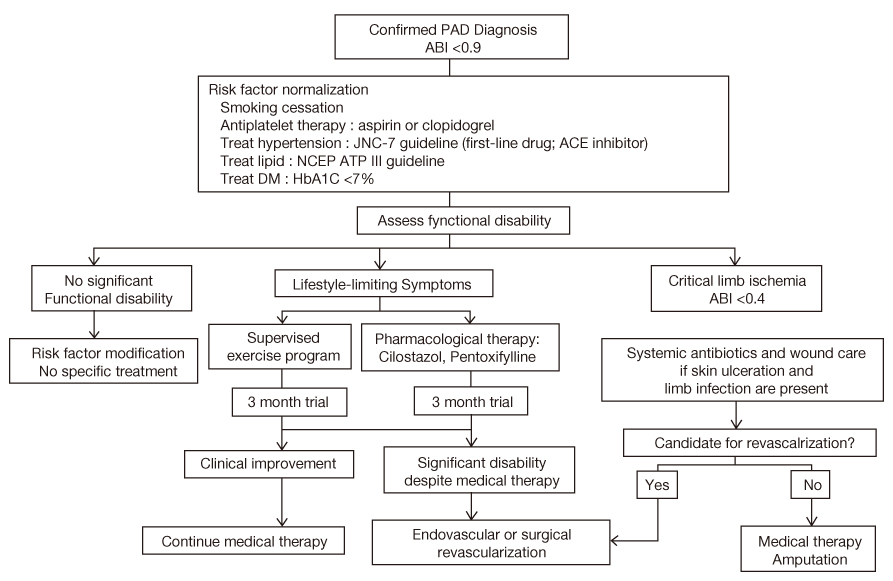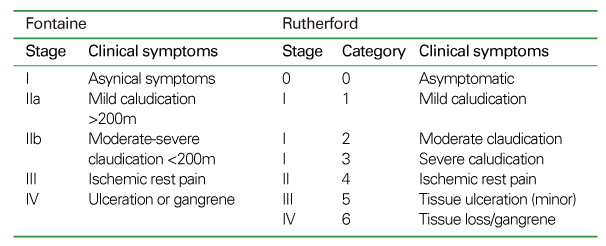 |
 |
- Search
| J Korean Med Assoc > Volume 53(3); 2010 > Article |
Abstract
Peripheral arterial disease (PAD) is defined as atherosclerotic disease of infrarenal aorta and arteries of the lower extremities. PAD is a frequent but underdiagnosed and undertreated disease with substantial cardiovascular morbidity and mortality. Accordingly, early recognition of PAD is crucial to initiation of therapy. The ankle-brachial index (ABI) is a simple, inexpensive and noninvasive test to confirm the diagnosis of PAD and also provides risk stratification for the future cardiovascular events. Therefore, ABI should be measured in all patients with suspected PAD. Lifestyle adjustment and supervised exercise program are a major support for the therapy. Modification of treatable risk factors in conjunction with antiplatelet therapy improves cardiovascular outcomes. Cilostazol can be used as the first-line pharmacotherapy agent for the relief of claudication symptoms. Mechanical revascularization should be reserved for patients with critical limb ischemia or lifestyle limiting claudication. Remarkable technological advances in endovascular treatment have shifted revascularization strategies from traditional open surgery toward lower-morbidity percutaneous endovascular treatments. The novel therapies for increasing pain-free walking distance are under investigation. Above all, improved awareness and education in both primary physicians and the patients with cardiovascular risk factors can decrease morbidity and mortality secondary to atherosclerotic vascular disease.
References
1. Selvin E, Erlinger TP. Prevalence of and risk factors for peripheral arterial disease in the United States: results from the National Health and Nutrition Examination Survey, 1999-2000. Circulation 2004;110:738-742.
2. Hirsch AT, Criqui MH, Treat-Jacobson D, Regensteiner JG, Creager MA, Olin JW, Krook SH, Hunninghake DB, Comerota AJ, Walsh ME, McDermott MM, Hiatt WR. Peripheral arterial disease detection, awareness, and treatment in primary care. JAMA 2001;286:1317-1324.
3. Choi DH, Pyun WB, Yoon YS, Jang Y, Shim WH. Frequency of Combined Atherosclerotic Disease of the Coronary, Periphery, and Carotid Arteries Found by Angiography. Korean Circ J 1999;29:883-890.
4. Becker GJ, McClenny TE, Kovacs ME, Raabe RD, Katzen BT. The importance of increasing public and physician awareness of peripheral arterial disease. J Vasc Interv Radiol 2002;13:7-11.
5. Lu JT, Creager MA. The relationship of cigarette smoking to peripheral arterial disease. Cardiovasc Med 2004;5:189-193.
6. Beckman JA, Creager MA, Libby P. Diabetes and atherosclerosis: epedimiology, pathophysiology, and management. JAMA 2002;287:2570-2581.
7. Hirsch AT, Haskal ZJ, Hertzer NR, Bakal CW, Creager MA, Halperin JL, Hiratzka LF, Murphy WR, Olin JW, Puschett JB, Rosenfield KA, Sacks D, Stanley JC, Taylor LM Jr, White CJ, White J, White RA, Antman EM, Smith SC Jr, Adams CD, Anderson JL, Faxon DP, Fuster V, Gibbons RJ, Hunt SA, Jacobs AK, Nishimura R, Ornato JP, Page RL, Riegel B. ACC/AHA 2005 practice guidelines for the management of patients with peripheral arterial disease (lower extremity, renal, mesenteric, and abdominal aortic): a collaborative report from the American Association for Vascular Surgery/Society for Vascular Surgery, Society for Cardiovascular Angiography and Interventions, Society for Vascular Medicine and Biology, Society of Interventional Radiology, and the ACC/AHA Task Force on Practice Guidelines (Writing Committee to Develop Guidelines for the Management of Patients With Peripheral Arterial Disease): endorsed by the American Association of Cardiovascular and Pulmonary Rehabilitation; National Heart, Lung, and Blood Institute; Society for Vascular Nursing; TransAtlantic Inter-Society Consensus; and Vascular Disease Foundation. Circulation 2006;113:e463-e654.
8. Ankle Brachial Index Collaboration. Ankle brachial index combined with Framingham Risk Score to predict cardiovascular events and mortality: a meta-analysis. JAMA 2008;300:197-208.
9. Norgren L, Hiatt WR, Dormandy JA, Nehler MR, Harris KA, Fowkes FG, Rutherford RB. Inter-society consensus for the management of peripheral arterial disease (TASC II). J Vasc Surg 2007;45:S5-S67.
10. Aboyans V, Criqui MH, Denenberg JO, Knoke JD, Ridker PM, Fronek A. Risk factors for progression of peripheral arterial disease in large and small vessels. Circulation 2006;113:2623-2629.
11. Ahimastos AA, Lawler A, Reid CM, Blombery PA, Kingwell BA. Brief communication: ramipril markedly improves walking ability in patients with peripheral arterial disease: a randomized trial. Ann Intern Med 2006;144:660-664.
12. Radack K, Deck C. β-adrenergic blocker therapy does not worsen intermittent claudication in subjects with peripheral arterial disease: a meta-analysis of randomized controlled trials. Arch Intern Med 1991;151:1769-1776.
13. Creasy TS, McMillan PJ, Fletcher EW, Collin J, Morris PJ. Is percutaneous transluminal angioplasty better than exercise for claudication? Preliminary results from a prospective randomised trial Eur J Vasc Surg 1990;4:135-140.
14. Lundgren F, Dahllof AG, Lundholm K, Schersten T, Volkmann R. Intermittent claudication-surgical reconstruction or physical training? a prospective randomized trial of treatment efficiency Ann Surg 1989;209:346-355.
15. CAPRIE Steering Committee. A randomised, blinded, trial of clopidogrel versus aspirin in patients at risk of ischaemic events (CAPRIE). Lancet 1996;348:1329-1339.
16. Thompson PD, Zimet R, Forbes WP, Zhang P. Meta-analysis of results from eight randomized, placebo-controlled trials on the effect of cilostazol on patients with intermittent claudication. Am J Cardiol 2002;90:1314-1319.
17. Coffman JD. Drug therapy: vasodilator drugs in peripheral vascular disease. N Engl J Med 1979;300:713-717.
18. Hansen PR, Holm AM, Qi JH, Ledet T, Rasmussen LM, Andersen CB. Pentoxifylline inhibits neointimal formation and stimulates constrictive vascular remodeling after arterial injury. J Cardiovasc Pharmacol 1999;34:683-689.
19. Girolami B, Bernardi E, Prins MH, Ten Cate JW, Hettiarachchi R, Prandoni P, Girolami A, Büuller HR. Treatment of intermittent claudication with physical training, smoking cessation, pentoxifylline, or nafronyl: a meta-analysis. Arch Intern Med 1999;159:337-345.
20. Lehert P, Comte S, Gamand S, Brown TM. Naftidrofuryl in intermittent claudication: a retrospective analysis. J Cardiovasc Pharmacol 1994;23:S48-S52.
21. Avellone G, Mandalá V, Pinto A, Martino A, Strano A. Clinical evaluation of short-term defibrotide treatment of patients with atherosclerosis obliterans of the lower limbs. Haemostasis 1986;16:55-58.
22. Brass EP, Anthony R, Cobb FR, Koda I, Jiao J, Hiatt WR. The novel phosphodiesterase inhibitor NM-702 improves claudication-limited exercise performance in patients with peripheral arterial disease. J Am Coll Cardiol 2006;48:2539-2545.
23. Nenci GG, Gresele P, Ferrari G, Santoro L, Gianese F. Mesoglycan Intermittent Claudication group. Treatment of intermittent claudication with mesoglycan-a placebo-controlled, double-blind study. Thromb Haemost 2001;86:1181-1187.
24. Takeshita S, Zheung LP, Brogi E, Kearney M, Pu LQ, Bunting S, Ferrara N, Symes JF, Isner JM. Therapeutic angiogenesis: A single intra-arterial bolus of vascular endothelial growth factor augments revascularization in a rabbit ischemic hindlimb model. J Clin Invest 1994;93:662-670.
25. Lederman RJ, Mendelsohn FO, Anderson RD, Saucedo JF, Tenaglia AN, Hermiller JB, Hillegass WB, Rocha-Singh K, Moon TE, Whitehouse MJ, Annex BH. TRAFFIC investigators. Therapeutic angiogenesis with recombinant fibroblast growth factor-2 for intermittent claudication (the TRAFFIC study): a randomized trial. Lancet 2002;359:2053-2058.
26. Rajagopalan S, Mohler ER III, Lederman RJ, Mendelsohn FO, Saucedo JF, Goldman CK, Blebea J, Macko J, Kessler PD, Rasmussen HS, Annex BH. Regional angiogenesis with vascular endothelial growth factor in peripheral arterial disease: a phase II randomized, double-blind, controlled study of adenoviral delivery of vascular endothelial growth factor 121 in patients with disabling intermittent claudication. Circulation 2003;108:1933-1938.
27. Murphy TP, Ariaratnam NS, Carney WI, Marcaccio EJ, Slaiby JM, Soares GM, Kim HM. Aortoiliac insufficiency: long-term experience with stent placement for treatment. Radiology 2004;231:243-249.
28. Schillinger M, Sabeti S, Loewe C, Dick P, Amighi J, Mlekusch W, Schlager O, Cejna M, Lammer J, Minar E. Balloon angioplasty versus implantation of nitinol stents in the superficial femoral artery. N Engl J Med 2006;354:1879-1888.
29. Schillinger M, Sabeti S, Dick P, Amighi J, Mlekusch W, Schlager O, Loewe C, Cejna M, Lammer J, Minar E. Sustained benefit at 2 years of primary femoropopliteal stenting compared with balloon angioplasty with optional stenting. Circulation 2007;115:2745-2749.
30. Scheinert D, Scheinert S, Sax J, Piorkowski C, Bräaunlich S, Ulrich M, Biamino G, Schmidt A. Prevalence and clinical impact of stent fractures after femoropopliteal stenting. J Am Coll Cardiol 2005;45:312-315.
31. Fischer M, Schwabe C, Schulte KL. Value of the hemobahn/viabahn endoprosthesis in the treatment of long chronic lesions of the superficial femoral artery: 6 years of experience. J Endovasc Ther 2006;13:281-290.
32. Tepe G, Zeller T, Albrecht T, Heller S, Schwarzwälder U, Beregi JP, Claussen CD, Oldenburg A, Scheller B, Speck U. Local delivery of paclitaxel to inhibit restenosis during angioplasty of the leg. N Engl J Med 2008;358:689-699.
33. Varty K, Bolia A, Naylor AR, Bell PR, London NJ. Infrapopliteal percutaneous transluminal angioplasty: a safe and successful procedure. Eur J Vasc Endovasc Surg 1995;9:341-345.
34. Ingle H, Nasim A, Bolia A, Fishwick G, Naylor R, Bell PR, Thompson MM. Subintimal angioplasty of isolated infragenicular vessels in lower limb ischemia: long-term results. J Endovasc Ther 2002;9:411-416.
35. De Vries SO, Hunink MG. Results of aortic bifurcation grafts for aortoiliac occlusive disease: meta-analysis. J Vasc Surg 1997;26:558-569.
36. Veith FJ, Gupta SK, Ascer E, Ingle H, Nasim A, Bolia A, White-Flores S, Samson RH, Scher LA, Towne JB, Bernhard VM, Bonier P, Flinn WR, Astelford P, Yao JS, Bergan JJ. Six-year prospective multicenterrandomized comparison of autologous saphenous vein and expanded polytetrafluoroethylene grafts in infrainguinal arterial reconstructions. J Vasc Surg 1986;3:104-114.
- TOOLS
-
METRICS

-
Related articles in
J Korean Med Assoc -
Surgical treatment for gastroesophageal reflux disease2022 December;65(12)
Current status of health promotion in Korea2022 December;65(12)
Management of severe pediatric obesity2021 June;64(6)
Treatment of chronic fibrosing interstitial lung diseases2021 April;64(4)








